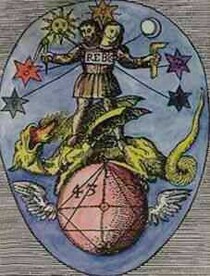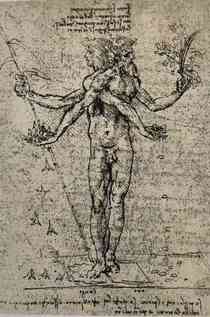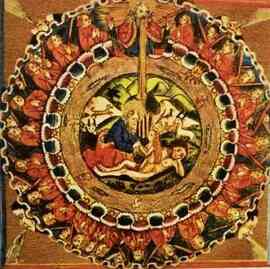 Home
Actueel
Visie
De 7 fasen
De Esoterische Evolutie
Boeken
Artikelen
Verwante teksten
Tegenkrachten
Over Margarete
Quotes / Test
Links / contact
Home
Actueel
Visie
De 7 fasen
De Esoterische Evolutie
Boeken
Artikelen
Verwante teksten
Tegenkrachten
Over Margarete
Quotes / Test
Links / contact
|
Esoteric Evolution - 19Why this seperation?The eras of development of the Earth:
The Bible tells us in Genesis 1:27 that the human being was created in the image of God, an image that is male-female. Prior chapters pointed out that the esoteric view of the evolution of the human being is fully in agreement with this statement. Rudolf Steiner describes that in the first half of the era of Lemuria the human being - he was then still "becoming," physically he was still fully "in development" - was androgynous, female and male in one. As precursor of the human being of today he still had both sexes undifferentiated in him. How should we picture that? No differentiationAndrogynous and undifferentiated mean that the male and the female, the fertilizing and the to be fertilized element are both present, but in a mixed form within one body. Therefore, not separated in two different bodies. As was related in chapter 16, The Androgynous Human Being in Antiquity and Paradise, the androgynous human being inclined more to the female than the male. We may therefore say that "woman" had the male aspect, or "man," in herself. This meant that she could be fertilized from inside. Procreation was at that time not an event from outside such as today, but it took place entirely within one body. This form of procreation is called "self-fertilization from inside," or "asexual" or "virginal" procreation. In those ancient eras fertilization was limited to certain times, when the milky sap with which the precursors of the human being fed themselves had forces in it that caused them to be fertilized as they were eating. High spiritual beings from the angelic hierarchies were involved when this happened. They overshadowed the becoming human beings and caused fertilization to take place and offspring to be generated.1) The mandate to become an individualIt was characteristic for descendants in those times that they did not have any individually distinguishing traits. They looked in every respect like their parents and ancestors - yes, they almost seemed to be imprints of those. The mandate, the task of human beings, however, is to bring the spirit, the divine principle in them, to expression in a unique, individual way. Only then does evolution proceed in the right direction. To achieve this, it was necessary that human beings received their own I. That gave them the possibility to develop their own personality and become a self-aware individual. Through the I, each one of them could develop in their own unique way and distinguish themselves from others. It was, and is, the intention that out of this I-consciousness human beings develop their spiritual core, their spiritual self, in an individual way. That is what the creative spiritual beings, the Elohim, had in view for humanity. Such a process was not possible as long as human beings were androgynous and all the descendants looked like their ancestors. For the process of individualization to succeed, single sexes were needed, so that in the course of human evolution androgyny was superseded by single sexes. Androgyny passed over into separate male and female sexuality, and thus into separate men and women. Only in this way was it possible to generate a human being who in the course of human development would become more and more individual. This individualization was the reason why Yahweh-Elohim, the leading godhead, gradually transformed the old form of self-fertilization within a body into fertilization from outside. This new way of fertilization came about, and still comes about, by women and men acting together in sexual contact. As indicated in the previous chapter, especially the male element proves to be essential for the individualization process. Rudolf Steiner also pointed this out: "Through the male element the individual element arose in the human being."2) One of the subsequent chapters will show that the split into two sexes was also of the greatest importance for the development of the soul and the personality-I.
The androgynous human being The process of the split into two sexesHow did the change from androgyny to the two sexes take place? In this transition the effect of the Moon, which shortly before had separated from the Earth, played an essential role. As was related before, during Lemuria Yahweh-Elohim caused the Moon to separate from the Earth. In contrast to the other Elohim, who received a dwelling place on the Sun, Yahweh-Elohim remained connected with the Moon. Rudolf Steiner relates that the process of the split into two sexes began when the Moon forces of Yahweh-Elohim, which were now working from outside into the Earth, gradually caused a split into two groups to come about in the organs of procreation in the human body. One group had more "etheric-experiencing geminating force" and the other more "spiritual-soul germinating force." We can recognize in these the fertilizing and the to-be-fertilized elements. This separation into two groups, at first still within one body, caused radical changes to occur in the becoming human being. The result was that very gradually the bodies showed either more characteristics of the female sex, or of the male sex. But that did not mean that the separation into two sexes had already happened at that point. For that to develop, the one-sidedness of each side had to increase and become stronger.
The TransitionIn spite of the fact that this gigantic process of change was happening in the precursors of the human being, and the bodies began to show more and more male resp. female characteristics, for a long time they were still able to fertilize themselves from inside, and thus procreate. The separation only became a reality when in the one individual no fertility, meaning the possibility that the female ovum was fertilized from inside, existed anymore. That was the time when the fertilizing force had moved completely into the other sex, the male. Thus, eventually two different individuals came into being, one with a female body, the other with a male body, or women and men.3) In the BibleDuring the time of transition to the two sexes old, androgynous, virginal procreation and new sexual procreation existed side by side for a long time. In one human being procreation was still androgynous, while in another the new way was already taking place. That lasted until the time when the possibility of self-fertilization ceased completely. The split into two sexes and the resulting way of fertilization had then become a definitive fact. In the Bible we also find a description of the split into two sexes, namely in Genesis 2:22 which speaks of the creation of woman: "And the rib which the Lord God had taken from the man he made into a woman…" It is remarkable that only in Gensis 3:20 the name of the woman is pronounced: Eve. The name Adam, as the name of the man, we hear even later, in Genesis 4:2, where we are told that Adam had intercourse with his wife. The terminology used indicates the new situation - the new condition resulting from the split into two sexes. Before that time, we don't see any personal names. Before Genesis 2:22 the Bible speaks of the human being in terms of "human being" (adamah). That is because at that time androgyny was still predominant. And the descent of the I, the principle of individualization, had not yet taken place. The personal element, which a name indicates, thus did not yet exist before Genesis 2:22. In the animal worldRudolf Steiner emphasizes that before the split into two sexes was a fact for human beings, there already existed animals - of course in the forms they had at the time - in two sexes.4) That was related with the fact that animals are connected with the astral element in a different way than human beings, and also because they have no I. It is interesting to know that even in our time, among the lower animal species, there are animals that are not only androgynous and procreate virginally, but can also procreate through sexual contact from outside if necessary. They are wonderful examples of what is described above. They preserved both methods of fertilization. How can that be? This becomes understandable if we consider that these lower animal species separated from the general human corporeality when during Lemuria fertilization gradually transitioned from self-fertilization to fertilization through sexual contact. Their appearance as well as their way of procreation show that, because they separated out at that stage, they remained stuck, as it were, in a particular phase of evolution and thus hardened in a particular form. In that state they preserved both methods of procreation. We see this combination of the old and the new way of fertilization in our time in lower animal species that separated out in those times, such as amphibians, insects, and reptiles including some frogs, and also aphids, snakes, and Komodo dragons. The last one is interesting because it is the only vertebrate that can procreate androgynously and can generate both male and female offspring.5)
Embryonic developmentBut not only in animals, also in humans we can still today find that original condition dating back to Lemuria albeit in a different form than in animals. Where can we see that? In the development of the human embryo. Embryology tells us that the human embryo, as it grows in the mother after fertilization, is in the first seven weeks still androgynous. That is because in that period the embryo is still sexually undifferentiated. Basically, both sexes are present, but one of them has not yet crystallized, despite the fact that the future sex, by the contribution of the father, is already certain. That situation changes only in the sixth to the eighth week. Then the opposite sexual principle shrivels up into small remnants and a clearly male or female body makes its appearance. However, the rudimentary remnants of the organic structure of the other sex - the male in the woman, and the female in the man - continue to exist and are a lifelong reminder of the fact that the human being is originally and essentially androgynous.6) The situation in the futureIn this connection, Rudolf Steiner tells us something quite extraordinary. In the future, he said, and not even that far in the future, today's single sexuality - our being either man or woman - will change again. Human beings will then be androgynous again. When and why will that happen? It will happen when the task that is connected with the separation into two sexes has been fulfilled, namely when the I-process, the individualization process, has developed to such an extent that a strong inner connection with the world of the spirit, the spiritual self, has grown, and when we live out of that. Then the sexuality of the human being will become androgynous again. It is interesting that the apocryphal Gospel of Thomas already describes this condition. The Gospel of Thomas consists of 114 separate statements by Jesus. In statement 22 he says: When you make the two into one, "The kingdom" in this connection means the world of the divine. We will enter it or, in different words, it opens to us if we fully unfold the divine core in us, our spiritual self, and if it will determine our life. In conclusion Rudolf Steiner indicated that the new androgyny will incline more to the male element than to the female. This self-aware, new human being, male-female in nature, living out of his spiritual self, will then be a human being in the true significance of the word. Sources
See for English translations of Steiner texts: https://rsarchive.org. © Margarete van den Brink 2007-2025 - www.margaretevandenbrink.nl
|





 The Creation
The Creation


